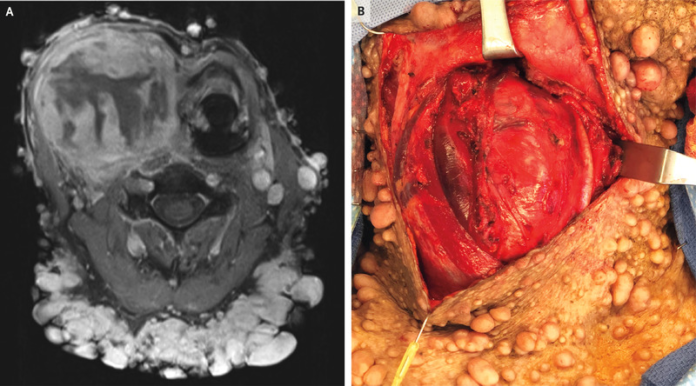Case of malignant peripheral nerve-sheath tumour
Malignant peripheral nerve-sheath tumour, also referred to as MPNST is defined as a cancer of the cells that form the sheath covering and protecting the peripheral nerves. Peripheral nerves are the nerves outside the central nervous system, brain, and spinal cord. It is a type of sarcoma which grows in the soft tissue of the body, for example, nerves, blood vessels, lymph, ligaments, tendons, fat, and muscle, including other tissue that connects and supports the body. The tumour grows quickly and can spread to other parts of the body.
Case study
This article describes the case of a malignant peripheral nerve-sheath tumour in a 61-year-old man with neurofibromatosis type I. The patient presented to the outpatient clinic with an enlarging mass in his neck. Physical examination showed extensive cutaneous neurofibromatosis and a large, firm mass in the right side of his neck. This also caused leftward tracheal deviation. Doctors advised an MRI. Findings of the MRI showed a large, heterogenous neck mass that caused displacement of the vasculature and trachea. during surgical removal of the mass, a mass measuring 11.5 cm by 6.5 cm by 6.0 cm was resected.
Histopathology of the mass revealed a malignant peripheral nerve-sheath tumour. The tumours are aggressive soft tissue sarcomas that develop within preexisting plexiform neurofibromatosis in patients with neurofibromatosis type 1. Doctors treated the patient with adjuvant radiotherapy and chemotherapy. The patient was called for a follow-up four months after completing treatment and there was no evidence of recurrent disease.
Sarcomas are rare cancers, whereas MPNST is a rare type of sarcoma that accounts for only 5% to 10% of cases of sarcomas. It is more commonly seen in young adults and middle-aged adults, more commonly diagnosed in people with neurofibromatosis type 1 (NF1). 25% to 50% of patients diagnosed with MPNST have NF1 and 8% to 13% of people with NFI are diagnosed with MPNST in their lifetime.
References
Source: NEJM




